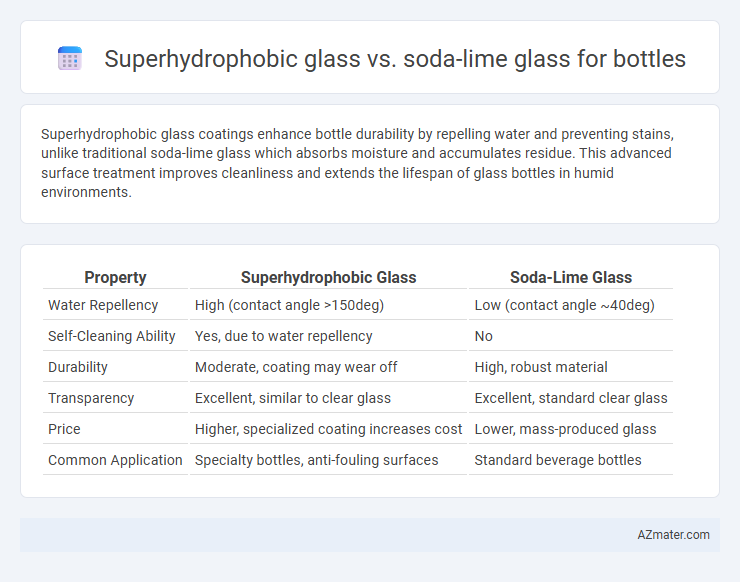Superhydrophobic glass coatings enhance bottle durability by repelling water and preventing stains, unlike traditional soda-lime glass which absorbs moisture and accumulates residue. This advanced surface treatment improves cleanliness and extends the lifespan of glass bottles in humid environments.
Table of Comparison
| Property | Superhydrophobic Glass | Soda-Lime Glass |
|---|---|---|
| Water Repellency | High (contact angle >150deg) | Low (contact angle ~40deg) |
| Self-Cleaning Ability | Yes, due to water repellency | No |
| Durability | Moderate, coating may wear off | High, robust material |
| Transparency | Excellent, similar to clear glass | Excellent, standard clear glass |
| Price | Higher, specialized coating increases cost | Lower, mass-produced glass |
| Common Application | Specialty bottles, anti-fouling surfaces | Standard beverage bottles |
Introduction to Glass Types in Bottle Manufacturing
Superhydrophobic glass offers enhanced water repellency and self-cleaning properties, making it ideal for bottles requiring durability and hygiene. Soda-lime glass, the most common type in bottle manufacturing, combines affordability with good strength and chemical resistance. Comparing these glass types highlights the balance between performance benefits and cost-effectiveness in bottle production.
Understanding Superhydrophobic Glass Technology
Superhydrophobic glass features a nanostructured surface that repels water and reduces contamination, enhancing bottle durability and cleanliness compared to traditional soda-lime glass. Its water contact angle typically exceeds 150 degrees, creating a self-cleaning effect that prevents liquid adhesion and microbial growth. This innovative technology extends the lifespan of glass bottles by minimizing surface wear and maintaining optical clarity under various environmental conditions.
What is Soda-lime Glass? Composition and Properties
Soda-lime glass, the most common type of glass used for bottles, consists primarily of silica (SiO2), sodium oxide (Na2O), and calcium oxide (CaO), providing durability and chemical stability. Its composition typically includes about 70-74% silica, 12-16% sodium oxide, 5-11% calcium oxide, and minor amounts of other oxides that enhance its workability and strength. This glass exhibits moderate hardness, good transparency, and resistance to environmental factors, making it an economical choice for container manufacturing compared to specialized Superhydrophobic glass.
Water Repellency: Superhydrophobic vs Soda-lime Glass
Superhydrophobic glass exhibits exceptional water repellency with contact angles exceeding 150deg, causing water droplets to bead and roll off effortlessly, significantly reducing surface wetting and contamination. In contrast, soda-lime glass typically has contact angles around 20-30deg, leading to higher water adhesion and increased surface wetness. The enhanced water repellency of superhydrophobic glass makes it ideal for bottle applications requiring self-cleaning and anti-fouling properties, whereas soda-lime glass offers standard performance without specialized water resistance.
Durability and Scratch Resistance Comparison
Superhydrophobic glass exhibits superior durability and scratch resistance compared to traditional soda-lime glass used in bottles due to its advanced surface coating technology that repels water and reduces friction. The hydrophobic layer enhances resistance to chemical corrosion and physical abrasions, extending the lifespan of bottles under harsh conditions. In contrast, soda-lime glass is more prone to surface scratches and wear over time, limiting its durability in everyday use.
Impact on Bottle Cleanliness and Hygiene
Superhydrophobic glass on bottles significantly reduces water and dirt adhesion, promoting enhanced cleanliness by preventing residue buildup compared to traditional soda-lime glass. This advanced surface technology inhibits microbial growth and reduces contamination risks, improving overall hygiene. Soda-lime glass, while durable and cost-effective, tends to retain moisture and grime, increasing cleaning frequency and potential bacterial presence.
Thermal and Chemical Resistance Analysis
Superhydrophobic glass demonstrates superior thermal resistance compared to soda-lime glass, enduring higher temperatures without deformation or loss of integrity, making it ideal for applications requiring heat exposure. Chemically, superhydrophobic glass exhibits enhanced resistance to acidic and alkaline substances due to its non-wetting surface, which minimizes chemical interaction and corrosion. In contrast, soda-lime glass is more prone to chemical attack and thermal shock, limiting its durability in harsh environments.
Cost Implications for Manufacturers
Superhydrophobic glass typically incurs higher production costs than standard soda-lime glass due to advanced surface treatments and specialized coatings that enhance water repellency. Soda-lime glass, widely used in bottle manufacturing, remains cost-effective due to abundant raw materials and established mass production techniques. Manufacturers must weigh the premium expenses of superhydrophobic glass against potential benefits such as improved durability and reduced cleaning frequency in downstream processes.
Sustainability and Environmental Considerations
Superhydrophobic glass for bottles offers enhanced sustainability through its self-cleaning properties, reducing water and chemical use during maintenance compared to traditional soda-lime glass. Soda-lime glass, while widely recyclable and made from abundant raw materials like silica sand, requires higher energy consumption during production and frequent cleaning cycles without hydrophobic properties. The durability and reduced resource needs of superhydrophobic coatings contribute to lower environmental impact and extended lifecycle benefits over conventional soda-lime glass bottles.
Choosing the Right Glass: Superhydrophobic vs Soda-lime for Bottles
Superhydrophobic glass offers superior water repellency and self-cleaning properties, making it ideal for bottles exposed to moisture and dirt, enhancing durability and hygiene. Soda-lime glass, the most common and cost-effective type, provides good strength and chemical resistance but lacks water-repellent features, which may require more frequent cleaning. Choosing between superhydrophobic and soda-lime glass depends on budget constraints, intended usage conditions, and the priority of maintenance convenience versus initial cost.

Infographic: Superhydrophobic glass vs Soda-lime glass for Bottle
 azmater.com
azmater.com